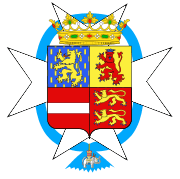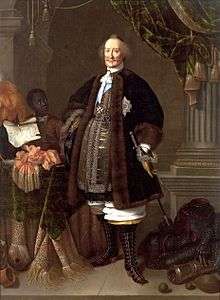John Maurice, Prince of Nassau-Siegen
| John Maurice of Nassau | |||||
|---|---|---|---|---|---|
|
Count of Nassau-Siegen Prince of Nassau-Siegen | |||||
|
| |||||
| Governor of Dutch Brazil | |||||
| Reign | 23 January 1637 – 30 September 1643 | ||||
| Born |
17 June 1604 Dillenburg, Holy Roman Empire | ||||
| Died |
20 December 1679 (aged 75) Kleve, Holy Roman Empire | ||||
| Burial | Kleve | ||||
| |||||
| House | Nassau | ||||
| Father | Johann VII, Count of Nassau-Siegen | ||||
| Mother | Countess Magdalena of Waldeck | ||||
| Religion | Calvinism | ||||
John Maurice of Nassau (Dutch: Johan Maurits van Nassau-Siegen[lower-alpha 1], German: Johann Moritz von Nassau-Siegen, Portuguese: João Maurício de Nassau-Siegen, 17 June 1604 – 20 December 1679), called "the Brazilian", was count and (from 1674) prince of Nassau-Siegen, and Grand Master of the Order of Saint John (Bailiwick of Brandenburg).
Early years in Europe
He was born in Dillenburg. His father was John VII of Nassau; his grandfather John VI of Nassau, the younger brother of Dutch stadtholder William the Silent of Orange, making John Maurice a grandnephew to William the Silent.
John Maurice joined the Dutch army in 1621, at a very early age. He distinguished himself in the campaigns of his cousin, the stadtholder Frederick Henry, Prince of Orange. In 1626 he became captain. He was involved in 1629 in the capture of Den Bosch. In 1636, he conquered a fortress at Schenkenschans.
Dutch governor in Brazil

He was appointed as the governor of the Dutch possessions in Brazil in 1636 by the Dutch West India Company on recommendation of Frederick Henry. He landed at Recife, the port of Pernambuco and the chief stronghold of the Dutch, in January 1637.
By a series of successful expeditions, he gradually extended the Dutch possessions from Sergipe on the south to São Luís de Maranhão in the north. With the assistance of the famous architect, Pieter Post of Haarlem, he transformed Recife by building a new town adorned with public buildings, bridges, channels and gardens in the then Dutch style, later naming the newly reformed town Mauritsstad, after himself.
By his statesmanlike policy he brought the colony into a most flourishing condition. His leadership in Brazil inspired two Latin epics from 1647: Caspar Barlaeus' Rerum per octennium in Brasilia et alibi nuper gestarum sub praefectura[1] and Franciscus Plante's Mauritias. The painters Albert Eckhout, Frans Post, and Abraham Willaerts served as members of John Maurice's entourage.
In 1643 in Johan Maurits equipped the expedition of Hendrik Brouwer that attempted to establish an outpost in southern Chile.[2][3]
He also established representative councils in the colony for local government, and developed Recife's transportation infrastructure. His large schemes and lavish expenditure alarmed the parsimonious directors of the West India Company, and John Maurice, refusing to retain his post unless he were given a free hand, returned to Europe in July 1644.
Return to Europe
%2C_Count_of_Nassau-Siegen.jpg)
He was shortly afterwards appointed by Frederick Henry to the command of the cavalry in the Dutch army, and he took part in the campaigns of 1645 and 1646. When the war was ended by the Peace of Münster in January 1648, he accepted from the elector of Brandenburg the post of governor of Cleves, Mark and Ravensberg, and later also of Minden. His success in the Rhineland was as great as it had been in Brazil, and he proved himself a most able and wise ruler.
At the end of 1652, John Maurice was appointed head of the Order of Saint John (Bailiwick of Brandenburg) and made a prince of the Empire. In 1664 he came back to Holland; when war broke out with an England supported by the invading bishop of Münster, he was appointed commander-in-chief of the Dutch States Army. Though hampered in his command by the restrictions of the states-general, he repelled the invasion, and the bishop, Christoph Bernhard von Galen, nicknamed "Bommen Berend", was forced to conclude peace. His campaigning was not yet at an end, for in 1668 he was appointed first Field-Marshal of the States Army and in 1673 he was charged by stadtholder William III to command the forces in Friesland and Groningen, and to defend the eastern frontier of the Provinces, again against Van Galen.

In 1675 his health compelled him to give up active military service, and he spent his last years in his beloved Cleves, where he died in December 1679.
Legacy
The residence he built in The Hague is now called the Mauritshuis, and houses the Royal Cabinet of Paintings. It is now a major museum of old Dutch paintings.
Brazilian author Paulo Setúbal wrote a historic novel about John Maurice and the Dutch settlement in Brazil, O Príncipe de Nassau ("The Prince of Nassau", translated into Dutch by R. Schreuder and J. Slauerhoff in 1933 as Johan Maurits van Nassau).
Notes
- ↑ Pronounced [ˈjoɦɑn ˈmɑʏrɪt͡s vɑn nɑˈsɑʏ ˈsiɣɑ̃ː].
References
- ↑ Facsimile of 1647 first edition
- ↑ Robbert Kock The Dutch in Chili at coloniavoyage.com
- ↑ Kris E. Lane Pillaging the Empire: Piracy in the Americas, 1500-1750, 1998, pages 88-92
- Attribution
-
 This article incorporates text from a publication now in the public domain: Chisholm, Hugh, ed. (1911). "John Maurice of Nassau". Encyclopædia Britannica (11th ed.). Cambridge University Press.
This article incorporates text from a publication now in the public domain: Chisholm, Hugh, ed. (1911). "John Maurice of Nassau". Encyclopædia Britannica (11th ed.). Cambridge University Press.
External links
| Wikimedia Commons has media related to Johann Moritz Fürst von Nassau-Siegen. |
| John Maurice, Prince of Nassau-Siegen Born: 17 June 1604 Died: 20 December 1679 | ||
| Preceded by Georg von Winterfeld, Landvogt der Neumark, Komtur zu Schivelbein |
Herrenmeister (Grand Master) of the Order of Saint John 1652–1679 |
Succeeded by Georg Friedrich, Fürst zu Waldeck, Graf zu Pyrmont |
| Government offices | ||
|---|---|---|
| Preceded by Sigismund van Schoppe |
Governor of Brazilian Captaincy of Pernambuco 1637–1644 |
Succeeded by Hendrik Hamel |